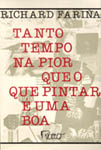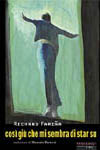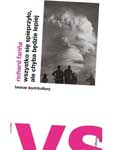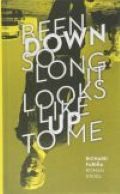
Been Down So Long It Looks Like Up To Me
New York: Random House, April 28, 1966.
Click on covers for larger images and more info.
Click here for reviews and literary criticism.
"I been down so long, seem like up to me,
Gal of mine got a heart like a rock in the sea."
--Furry Lewis, "Turn Your Money Green"
(adapted by Eric von Schmidt as "Stick With Me, Baby"
on the album Dick Fariña & Eric von Schmidt)
THIS NOVEL WAS DECODED WITH...
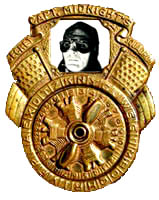
THE CAPTAIN MIDNIGHT
CODE-O-GRAPH
and escape from Reality.
An interpretation by
Douglas Cooke,
licensed Fariña nut
Published April 28, 1966, two days before Fariña died in a motorcycle
accident, Been Down So Long It Looks Like Up To Me became a cult favorite
among fans of his music and eventually attracted the attention of a more literary
readership through Fariña's association with Thomas Pynchon, who wrote a blurb
for the novel.
Fariña had mentioned Pynchon in the notes for his song "V." on Celebrations
for a Grey Day and also in his 1963 essay, "Monterey Fair," published in
Mademoiselle (March 1964). But Fariña was known for his name-dropping,
and cover blurbs are often commercially motivated. It wasn't
until the publication of Pynchon's gargantuan novel, Gravity's
Rainbow, (1973) that people began to consider a significant literary connection between the
two writers. That formidable brick of a book, which many regard as the most
important novel of the latter half of the 20th century,
was "Dedicated to Richard Fariña," and that tribute alone makes Been Down
So Long worthy of literary study.
In time Pynchon and Fariña came to be regard as part of a "Cornell School" of
writers, which included David Shetzline (author of the "ecological" novel,
Heckletooth 3, and DeFord, which was also dedicated to Fariña), and
M.F. Beal (author of Angel Dance, a detective
story with a Chicana lesbian investigator). Gene
Bluestein discerns three preoccupations that characterize the Cornell school:
"political paranoia (the idea of a Big Brother state), despair over the
destruction of the environment, and an awareness of the special impact on the
American mind of all levels of popular culture." (1)
The most famous author associated with Cornell was of course Vladimir Nabokov,
one of the great writers of this century, who taught at
Cornell in the late fifties while Pynchon and Fariña were students there.
Robert Scholes later recalled Fariña's enthusiasm for the great novelist:
i.) Background: The "Cornell School"
"About thirty years ago when I was a graduate student at Cornell, I was
standing in the hall of the building one day. A young man, an undergraduate
who was aspiring to be a writer at that time, came up to me. He had a book
in his hand, and he grabbed me and said, "you've got to hear this, you've
go to listen to this." He opened the book, and he started to read. "Lo-li-ta,
trippingly on the tongue," and he went on and read me the first several
paragraphs of Lolita. This young man, whose name was Richard Fariña,
became a writer and wrote a book called Been Down So Long It Looks Like
Up To Me." (2)
It was Leslie Feidler, the ornery and iconoclastic literary critic, who first
applied the architectural term "postmodern" to literature. He once explained
the term thus:
ii.) The Quest for the Real
Been Down So Long It Looks
Like Up To Me is the tale of a world-weary traveler who has been on
a voyage and seen many horrors and has returned a changed man, like the
blue-eyed son in Dylan's "A Hard Rain's A-Gonna Fall." But while the blue-eyed
son returns galvanized, ready to proselytize,
determined to confront the injustices he has seen, Fariña's character,
Gnossos Pappadopoulis, is reluctant to talk about
what he has seen. Like the taciturn heroes of Hemingway's fiction, he is
morally paralyzed by his experiences and now seeks only alleviation and escape.
Fariña's model for Gnossos is Odysseus, weary veteran of
the Trojan War, the prototypal anti-hero, the original draft-dodger, who
cares not for glory but just wants to go home. Gnossos' first mission in
the novel is to find a home, an apartment. The lyrical overture of the novel
is awash in allusions to The Odyssey. The entire novel,
especially the geographical names of this fictional college town (based on
Ithaca in Upstate New York, home of Cornell Univesity and of course namesake
of Odysseus's island), is littered with absurd classical allusions: we hear of Harpy
Creek, Dryad Road, the Plato Pit (a restaurant), Circe Hall (a women's dorm)
, Hector Ramrod Hall, Minotaur Hall, Labyrinth Hall, etc. Even Gnossos's
ridiculous name is oddly allusive. Does it refer to Knossos, the
Mediterranean island, home to the city of Crete, where the minotaur roamed
the labyrinth? (At one point we are told that Gnossos
"bellowed like a Cretan bull." (165)) (4) The name may
also allude to the Greek word for "knowledge." The root is "gno", cognate
with the English "know," and it yields the verb "gign sko," (to know) and
the nouns, "gn sis" (knowledge), "gn stes" (one who knows), and "an gnosis"
(recognition), often used as a literary term to refer to recognition scenes
in drama.
Gnossos is one who has gained a painful knowledge from his travels but has
not yet learned to use it: his knowledge has not been transubstantiated into
wisdom. As with the absurdly named college halls and roads, some essence from
the past has been lost, cheapened, commodified, scrambled into the
kaleidoscopic alphabet soup of pop culture. Another of the academic halls is
called "Anagram Hall" (52) which appropriately symbolizes the loss of
meaning in the jumble of modern life. Later in the novel we will meet G.
Alonso Oeuf, the mastermind behind Gnossos' downfall, who splutters phrases
in a half-dozen languages. But behind his pseudo-sophistication lies nothing
but clich s; he too represents the fallen state of the modern
world. Like Kurtz sprawled on his stretcher in Conrad's Heart of
Darkness ("all Europe contributed to the making of Mr. Kurtz"),
Oeuf seems a
conglomeration of enervated cultures, the weary terminal of history, an
ailing, infirm, meaningless scrapheap of allusions rotting in postmodern
squalor.
Gnossos' quest is to find the meaning behind the easy
allusions. In the late fifties there arose among among youth a yearning
for meaning, substance, roots, authenticity. Authenticity above all
was idealized by young discontents. It was, in
varying degrees, a catalyst of the Beat movement,
the Blues Revival, and the back-to-land communes and pastoral pilgrimages of
the Hippie movement. But it was a particular fetish of the urban folk revival.
In Positively 4th Street,
David Hajdu explains the appeal of folk music among college students
in the late fifties by noting that it coincided with the invention of
plastic: folk music "put a premium on naturalness and authenticity during
a boom in man-made materials, especially plastics." It was "a music that
glorified in the unique and the weird,
challenged conformity and celebrated regionalism during the rise of mass
media, national brands, and interstate travel." (5)
Been Down So Long It Looks Like Up To Me is set mainly in 1958, when
the folk music revival was just warming up (the Kingston Trio
scored a hit that year with the badman ballad "Tom Dooley").
But aside from the guitars, dulcimers and autoharps at house of Grun, a friend
of Gnossos, most of the musical references are to the jazz of the Beatniks.
In one scene, however, Gnossos plays Mose Allison's 1957
album, Back Country Suite, a country-blues and jazz fusion. As Mose Allison
blends the two genres,
Gnossos falls somewhere between the two movements. His outward rhythm is the
syncopated beat of jazz, but his inner song is the lonesome highway of folk.
He shares with both the beats and the folkies a contempt for the bourgeois,
the superficial, the mass-marketed.
Yet even Gnossos, for all his polymath learning, makes constant allusions to
Plastic Man, Captain Marvel, the Green Lantern, and other
comic book heroes. (6) He also identifies himself
with--and sometimes poses as--various figures throughout history: Montezuma
(22), Dracula, Prometheus (91), the Holy Ghost (171), Ravi Shankar (171),
Winnie the Pooh. He is a keeper of the flame, a seeker of the Holy Grail. He is
the antecedent of the character in Joni Mitchell's anthem, "Woodstock," who
says, "I don't know who I am, but life is for learning." Gnossos himself
realizes that he has "too many roles to play" (25).
Significantly, Gnossos'
favorite superhero is Plastic Man, who could stretch himself into any shape.
Plastic Man seems to have been a favorite of Fariña's as well;
he mentioned him in his essay "The Writer as Cameraman." (Mimi, in the
notes to Long Time Coming and a Long Time Gone, explained the
reference thus:
"As for Plasticman, Dick just loved all that weirdness, all that
cartoon-craziness; he really had that great sense of mush! I have an odd
feeling that they've met by now, he and Plasticman and all the rest.
I hope they're having a good laugh.") (7)
Amid all this posing Gnossos also attempts to assert his own ethnic identity.
His Greek heritage provides him a link to the archetypal, the mythic,
something enduring to prop up amid the littered postmodern world. Yet this
self-assertion of identity often takes mundane forms. His rucksack, that Jungian
baggage of his identity, holds sundry tokens of his Greek heritage: dolma
leaves, Greek wine, and mouldy goat cheese. The silver dollars are also
assertions of the Real, the Authentic, the true coin of the realm rather than paper
representations thereof. Explaining his use of silver dollars to Dean
Magnolia, he warns of "parasitic corruption that gets spread through the
handling of dollar bills." (54) When a cashier questions the silver dollars,
Gnossos claims that he is Montezuma and threatens to tear out her heart and
eat it raw. More posing, more delusions of heroic grandeur, the assertion of
an ancient archetype to muscle out the present, the ephemeral, the corrupt,
the artificial. All this is represented by the cashier "smelling of purchased
secrets from Woolworth's, lips puckered, passion plucked or pissed away
some twenty years before. The resigned are my foes." (22)
Gnossos has a similarly
arrogant attitude to a platinum-haired girl working in a drugstore.
"Deaf to her doom," he imagines, and ascribes another pathetic narrative to
her life:
Like his alternating identities, the Greek food and the silver dollars are
tumbled together in the rucksack with tokens of childhood fantasy, such as
rabbits' feet ("Placate all the gods and demons, finger in every mystical
pie" (114)) and the Captain Midnight Code-O-Graph, which loses a spring at a
significant moment in the story. When Gnossos learns that he has been partly
responsible for the death of Simon, a fellow student who killed himself upon
learning that his girlfriend was in love with Gnossos (who had seduced her
in an earlier chapter), he experiences what may be the silliest epiphany in
all literature:
iii.) The Deathwish
Am I reading too much into the contents of the rucksack? Perhaps. But this
epiphany is similar to another in a short story of Fariña's called "The
End of a Young Man," in which an American visiting Ireland assists in the
bombing of a patrol boat, then finds out that there had been people on board.
The young man's discovery that he was responsible for the death of another
person brings an end
to innocence and youth, just as Gnossos undergoes a fall from innocence,
here symbolized by the "boing" of the Code-O-Graph.
Carolyn Hester, in an interview with Richie Unterberger in Urban Spacemen
and Wayfaring Strangers,
(8) reveals that Fariña actually had such an adventure in Ireland,
where he was tricked by the IRA into believing that there would be no
people aboard the boat he was to bomb. Carolyn Hester makes no reference to
the short story, but she believes that Fariña was deeply affected by that
experience, and she felt that it explained much of his subsequent behavior.
Mimi Fariña also discussed Fariña's morbidity in the notes to Long Time
Coming and a Long Time Gone. Death haunts Fariña's music as well.
The song "Raven Girl," which his liner
notes describe as a deathwish, may reflect his guilt over the bombing of the
boat.
Perhaps this deathwish attracted Fariña to Michelangelo's poem,
"Sleep." Fariña quotes this poem both in Been Down So Long and in the short story
"The Good
Fortune of Stone." In the short story he quotes the poem in the original
Italian:
But sanity for Gnossos would lie somewhere between the untroubled,
patly-defined life of Gunsmoke junkies and
the nervous energy of the perpetually moving target. Gnossos' deathwish is
a yearning for quiescence, for the quelling of his conscience. The
impossibility of this yearning gives him a contempt for those who have some
modicum of peace in life, those who are "deaf to their own doom." In the
song, "Sell-Out Agitation Waltz," Fariña scorns such people
"who ain't aware that every
morning they wake up dead." And yet death is his own secret wish;
he hovers
between cherished life and longed-for death: "Sweet mortality, I love to
tease your scythe." (169)
Herein lies the protagonist's central conflict. He went in quest of something
Real, but he
has found and seen things of such terrifying reality that he needs to numb
himself. He anesthetizes himself through drugs, through his posture of
coolness, through masquerading as superheroes and other heroic figures of
myth and history, and most significantly through his declaration of Exemption.
iv.) Exemption
The delusion of exemption derives from some harrowing experiences in Gnossos'
travels. He almost died in the frozen snow of the Adirondacks while pursuing
a wolf; he witnessed an atom bomb explosion in Las Vegas; and watched someone
being tortured by pachucos in New Mexico. His escape from the
dangers he experienced has given him, at a conscious level, a belief that he
is exempt:
It is with relief that we watch Gnossos finally relinquish the rucksack, in
his usual ritualistic way, at the grave of Heffalump in Cuba. The rite of passage
into manhood seems long overdue, after his pre-novel travels, the death of
Simon, his brush with the clap, and the death of Heffalump. There are perhaps
too many mini-resolutions in the novel, too many epiphanies, too many karmic
adjustments rather than one big,
cathartic, aesthetically satisfying climax, and along the way we have to put up
with too much of Gnossos' posing and pointless partying. As a result, many
critics have overlooked the complexity and significance of the novel altogether,
dismissing it as an outdated effort now useful only as a document of its time.
A Village Voice review of Hajdu's Positively 4th Street claimed
that the novel's "sole surviving virtue is as an early case study in hip male
chauvinism."(10)
v.) Layers
I suspect Fariña did want his novel to be, like Fitzgerald's novels of the
twenties, a classic representation of the age that formed him. His fault,
then, lay not in being oblivious to the chauvinisms and flaws of Gnossos and
his age but in spending too much time creating the scene before leaving it.
After all, the epigraph to the novel is a quote from Benjamin Franklin, "I
must soon quit the scene," which Fariña pulled out of Lord knows where.
Clearly Been Down So Long was intended to be a bildungsroman,
a coming of age novel,
and not just a party novel. As a document of its time, Been Down
So Long does not succeed quite as well as The Electric Kool-Aid Acid Test,
which, though taking place five or six years later, has many interesting
parallels with Fariña's novel.(11)
There are many other themes in this complex
novel that I have not even addressed here, and many aspects that I still
do not understand, many allusions to pop culture, literature, science, and math
that I just don't get. Furthermore, there is reason to believe that despite
the years that Fariña devoted to writing and revising the novel, it never
became a fully-realized expression. Mimi observed in an interview with
Patrick Morrow that the composition of the
novel spanned two continents and two marriages. (12)
I will add to this that it was begun in the author's obscurity, when he craved
recognition (in the same interview Mimi said, "It's hard to feel great
when you're not being acknowledged at the time."), and it was finished when Fariña had achieved
the extraordinary success of two critically-acclaimed albums. Most first
novels are uneven, revealing imperfectly blended layers of experience, but
Fariña's was more uneven than most, begun, according to his own legend, a
few minutes after quitting his role as a blind harmonica player huckstering on
the streets of France, and completed by a respected musician acclaimed by
Pete Seeger and Jean Ritchie.
By his own admission, Fariña was still in the
process of "resolving the conflict between Inside and Outside," which he
describes as Gnossos' role as well, in an article written a few days before
he died. (13) A further complication in the novel's
genesis is that one of its major innovations, the use of illustrations to
portray episodes that would only be alluded to in the text itself, was rejected
by the publisher.
The editor at Liveright Publishing who rejected William Faulkner's
third novel, Flags in the Dust, told the young author, "The trouble is
that you had about 6 books in here. Your were trying to write them all at
once." (14)
This, I believe, is one of the problems with Fariña's confusing novel, the
outcome of two marriages, two continents, two careers, and God knows how many
conceptions of what the novel would be. But
when reading the first few novels of Faulkner we have the
more successfully executed genius of later novels to cast a clearer light on
the tentative, gestating ideas of the earlier work.
With Fariña we do not have that advantage. Guessing at his literary potential from
his novel is a bit like predicting
Judy Collins believed that Fariña was just beginning to
show a greater awareness of himself in the months before he died, and Joan
Baez's tribute to him implies the same. (15)
Just as his potential was incalcuable, so must
the more shadowy nooks of his novel remain unfathomable.
Douglas Cooke
For further criticism on this novel, see the
Literary Criticism
page.
1.) Bluestein, Gene. "Tangled Vines." (a review of Thomas
Pynchon's Vineland.) The Progressive. June 1990, Vol. 54, issue 6,
p. 42-3.
I'll try to say for the last time why I invented this term to begin with. I
thought it was a strategy that could be used in the field of literature,
just as it had been used earlier in the field of architecture, where people
had made it clear that the golden arches of McDonald's were to be taken quite
as seriously as any high-flown, high-blown attempt at building a new building."
(3)
Like Nabokov and Pynchon, Fariña gathers the trappings of contemporary American
life in all its tawdry plastic commercialism, forging from the materials of pop
culture a common language between
himself and his contemporary audience to tell a tale of high
seriousness through low humor. And like so many of the novels of Nabokov and Pynchon, Fariña's
novel is a quest.
See her in a year, straddling some pump-jockey in the front seat of a '46
Ford, knocked up. Watching Gunsmoke in their underwear, cans of Black Label,
cross-eyed kid screaming in a smelly crib. Ech. Immunity not granted to all.
As in the Montezuma scene, Gnossos requires heroic posing to assert
his superiority over her: explaining his use of bath oil, he says, "Ancient
custom is all, balm for warrior, makes you good to feel, right?" (171)
...while roaming the streets in a hopeless attempt to pace away an oily
guilt, to purge the accusing picture of Simon sucking an exhaust pipe, he
looked into his rucksack for a vial of paregoric to soothe his agitated
nerves. But instead he found the Code-O-Graph, neatly sprung in two where it
had been sitting, with all innocence of inanimate purpose, in a bed of
rabbit's feet. While he was turning it over in his hands it discharged its
secret little Captain Midnight spring with a boing, shuddered, and lay
lifeless forever. (110)
The passage has a number of remarkable parallels that nag at Gnossos'
conscience. Gnossos' craving for an opium-laced cigarette to smoke
corresponds to the image of Simon sucking on an exhaust pipe; one is an
unconscious mimickry of the other. The reference to "oily guilt" recalls an
earlier scene where Monsignor Putti comes to deliver Extreme Unction but
instead anoints Gnossos' feet in a "lovely sacrament," explaining that
one's feet "carry one to sin." (50) Yet now Gnossos seeks to "pace away" his guilt
by "roaming the streets," and he finds the epiphany of his lost innocence in
"a bed of rabbit's feet." (110) The themes of escape and guilt, futile
cautionary superstitions and reckless behavior are so inextricable linked that
they seem to hound each other in an eternal, hellish circle.
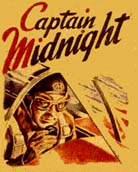
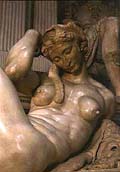
The sand that inches from the tide
Was Fariña haunted by the whispers of the dead? Like Tennyson's Ulysses,
who lost so many of his companions at sea, and in old age found that "the deep moans round
with many voices," perhaps Fariña was tormented by the memory of the men
killed on the boat.
Will claim the steps I sow,
The whispers in the ocean deep
shall pick my weary bones.
Caro m' il sonno e pi l'esser di sasso
In Been Down So Long, Gnossos translates part of the poem into English at a
frat party:
Mentre che'l danno e la vergogna dura,
Non veder, non sentir, m' gran ventura;
Per non me destar, deh! parla basso.(9)
"Dear to me is sleep...While evil and shame endure, not to see, not to feel
is my good fortune." (30)
Here is a translation of the entire passage:
"Dear to me is sleep, and dearer to be made of stone
The story "The Good Fortune of Stone" is another version of the wolf
story told in the novel. Pynchon states in his 1983 introduction to the novel
that Fariña told this story many times. The near-death experience recounted
in both versions of the wolf story must have touched him
profoundly, and this, combined with his feeling of guilt (vergogna),
may
have given him the conflicting impulses of a deathwish and a feeling of
exemption, two impulses which, it seems to me, are never entirely resolved
or sorted out from each other in the novel. Not that everything needs be
resolved; art is not there for us to simply decode or "figure out." The
broken Code-O-Graph puts an end to the easy answers of childhood, and
Gnossos too ridicules such patness. When Pamela says, "Must you be so
cryptic?" Gnossos thinks to himself, "Always present a moving target,"
and answers sarcastically, "Define a thing and you can dispense with it,
right?" (39)
While evil and shame endure,
Not to see, not to feel, is to me a good fortune,
Therefore do not wake me. Shh! Speak softly."I've been on a voyage, old sport, a kind of quest, I've seen
fire and pestilence, symptoms of a great disease. I'm exempt. (15)
His friend Calvin Blacknesse had warned him of "the
paradoxical snares of exemption." (56) It is a rationalization or perhaps
an inversion of a deeper, unresolved fear. Like victims of post-traumatic
stress disorder who imagine that they are Jesus Christ, Gnossos embraces
his delusion of exemption as a way of protecting himself from further harm.
Like Fariña, Gnossos is haunted by a pandemonium of phobias. He fears demons,
monkeys, all manner of bad omens which he seeks to avert by superstitious
rituals, such as the Mediterranean apotropaic ritual of clutching the testes.
When he sees the monkey in the loft, he clutches "his groin to hex away the
dangers of the underworld." (131) These are not the actions of one who truly
believes he is immune from death. Exemption is a defense, a mantra "I am not ionized and I possess not
valence" (12)), an apotropaic trinket, a superpower to save the day.
Brooklyn, 2001.
FOOTNOTES:
Return to essay.
2.) Coover, Robert, et al. "Nothing But Darkness and
Talk? Writers' Symposium on Traditional Values and Iconoclastic Fiction."
Critique. Summer, 1990, vol. 31, issue 4, p. 233ff.
Return to essay.
3.) Ibid.
Return to essay.
4.)
Fariña, Richard. Been Down So Long It Looks Like Up
To Me. New York: Random House, 1983. The Randon house and Penguin paperbacks
are both reprints of the original Random House edition, but the Dell paperback
was an entirely different typeset. Therefore, the page numbers in
this essay will apply to all but the Dell paperbacks.
Return to essay.
5.) Hajdu, David. Positively 4th Street: The Lives and
Times of Joan Baez, Bob Dylan, Mimi Baez Fariña, and Richard Fariña.
New York: Farrar, Straus and Giroux, 2001. Pages 10-11.
Return to
essay.
6.) When Fariña was writing the book in the early sixties,
comic books were just beginning to gain an older audience, as Stan Lee,
editor and head writer of Marvel Comics, created a new generation of more
realistic superheroes who had real-life problems, neuroses, and foibles.
In The Electric Kool-Aid Acid Test, published two
years after Fariña's novel, Tom Wolfe also observes the frequent
identification with comic book heroes, and their leotarded images began
appearing on album covers around this time. However, Fariña's novel takes
place in 1958, and Stan Lee's first experiments with the new comic book hero,
The Fantastic Four, did not arrive until 1961.
Return to
essay.
7.) Quoted in Fariña, Richard. Long Time Coming and a Long Time
Gone. New York: Random House. p. 40 (p. 36 of the Dell paperback). Mr. Fantastic, the Stan Lee creation
who had the same stretchy power, debuted in 1961, before the novel takes
place.
Return to essay.
8.) Unterberger, Richie. Urban Spacemen and Wayfaring
Strangers: Overlooked Innovators and Eccentric Visionaries of '60s Rock.
San Francisco: Miller Freeman Books, 2000.
Return to essay.
9.) Fariña, Richard. "The Good Fortune of Stone." Reprinted
in Long Time Coming and a Long Time Gone, p. 161 (p. 151 of the Dell
paperback).
Return to essay.
10.) Robert Christgau, "Folking Around," Village Voice,
June 26, 2001, p. 79.
Return to essay.
11.) Been Down shares many themes with The Electric
Kool-Aid Acid Test: the preoccupation with drugs, sex, superheroes, the
countercultural distrust of "the Establishment." Gnossos' urge to depart from society, conflicting
with his awareness that one always has to return to that society,
finds its parallel in the dilemma of the Merry Tricksters: no matter what heights
of discovery one reached through acid, one always had to return to earth,
one always had to come down. Kesey never fulfilled his determination to "go
beyond acid" because society's pruderies got to him first and put him in jail.
Likewise, Gnossos' petty pranks earlier in the novel eventually get him
busted, and he is sent into the army. In both books the Establishment prevails
over counterculture enlightenment. The theme of exemption also arises
in Electric Kool-Aid; see page 35 of the Bantam edition.
Return to essay.
12.) Morrow, Patrick. "Interview with Mimi Fariña."
Popular Music and Society, vol. 2, no. 1, Fall 1972. This interview is
available on this website. Click here.
Return to essay.
13.) "The Writer as Cameraman." Long Time Coming and a
Long Time Gone," p. 41-42.
Return to essay.
14.) Blotner, Joseph. Faulkner: A Biography. Revised
one-volume edition. New York: Vintage, 1991. p. 223.
Return to essay.
15.) Collins, Judy. The Judy Collins Songbook.
New York: Grosset & Dunlap, 1969. p. 185; and Baez, Joan. Daybreak.
New York: Dial Press, June, 1969. p. 135-136. I quote Judy Collins:
"I've always thought that Richard was just breaking through into some greater
perception of himself and other people when he died. He knew there was someone
at home inside his wildly imaginative head, and he was starting to come into
contact with it, to let it out."
Return to essay.







